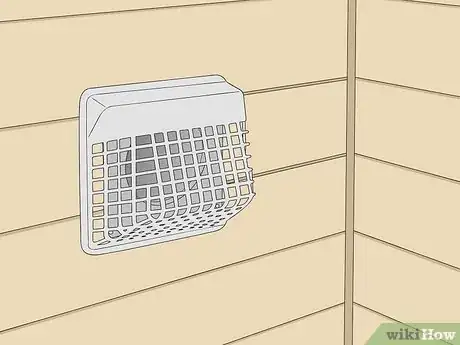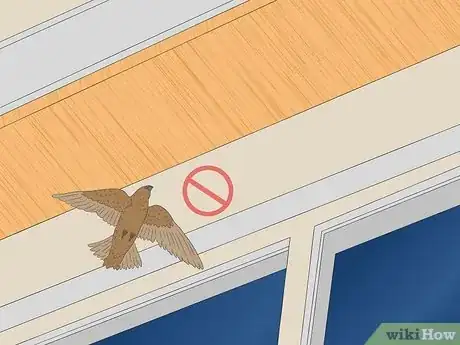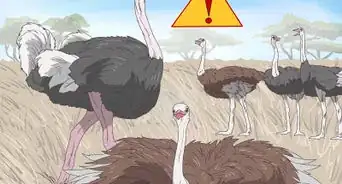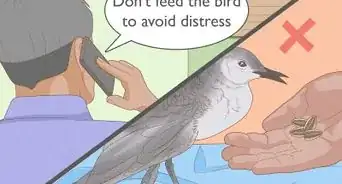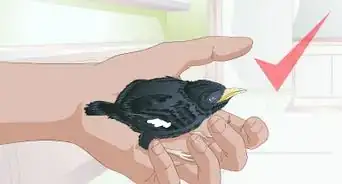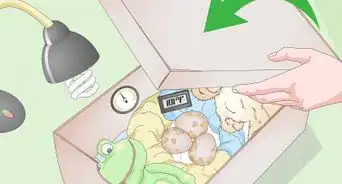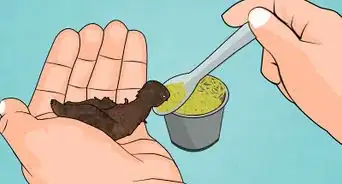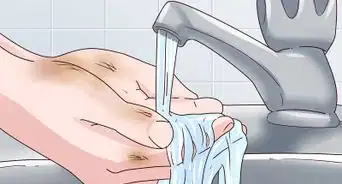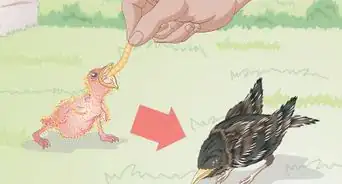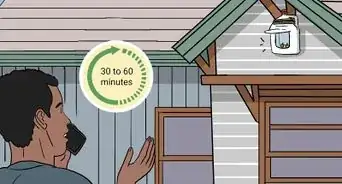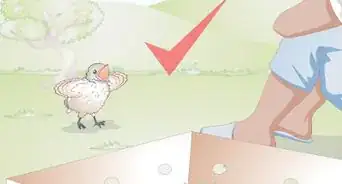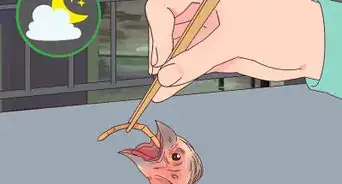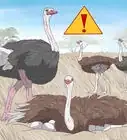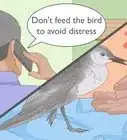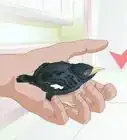This article was co-authored by Roger J. Lederer, PhD. Dr. Roger Lederer is an Ornithologist and the founder of Ornithology.com, an informative website about wild birds. Dr. Lederer has spent over 40 years teaching, studying, and writing about birds. He has traveled to over 100 countries to study birds. Dr. Lederer is an Emeritus Professor of Biological Sciences at California State University, Chico, and has been a Department Chair of Biological Sciences and Dean of the College of Natural Sciences. He has written more than 30 research papers and 10 books on birds and a textbook entitled “Ecology and Field Biology.” Dr. Lederer has consulted the BBC, National Geographic, National Public Radio, ABC News, the Guinness Book of World Records, and numerous other organizations and publications.
There are 9 references cited in this article, which can be found at the bottom of the page.
This article has been viewed 103,225 times.
Although bird nests can be beautiful to look at, they may cause major problems if built in the wrong place. A bird nest built in a vent, roof, or gutter can seriously damage them. If birds frequently nest near your home and you want to get rid of them humanely, you have many options. Depending on your preferences, you can set up barriers, use non-toxic repellents, or scare the birds away by building fake predators.
Steps
Setting Up Barriers
-
1Use porcupine wire to deter birds from landing on rafters. Porcupine wire creates an uneven landing place, which makes any birds nesting there unlikely. Lay out a length of porcupine wire over any rafters where you don't want birds to nest to keep them away.[1]
- Porcupine wires have heavy prongs that stick out in every direction, and they can be purchased online or at most hardware stores.
-
2Lay out bird netting over large areas where you don't want birds to nest. If you have a garden or outdoor item that you want to keep free of bird nests, cover it with mesh bird netting. This will keep birds and other small animals from accessing the area as long as the netting stays in place.[2]
- Hammer the netting into the ground with stakes to keep it securely over the area.
- You can also place spokes on top of buildings to keep birds from landing on the roof.[3]
Advertisement -
3Use protective covers to keep birds from nesting in vents. Purchase a vent cover or length of wire mesh from your local hardware store and place it over any vent openings outside. This will prevent birds from making nests in your vents.[4]
-
4Cover any ledges with wooden boards. Place a board at an angle greater than 45 degrees over any outdoor ledges where you don't want birds to nest. Birds will be unable to land on ledges with boards and will choose somewhere else to build their nest.[5]
Trying Scare Tactics
-
1Put up plastic predators near the areas where you don't want birds to roost. Birds look out for their natural predators and avoid nesting in places that seem to be a threat. Place a few plastic owls, snakes, or foxes near any areas that you want to keep nest-free. When a bird sees the plastic animals, it will find somewhere else to nest.
-
2Create makeshift predator scarecrows out of balloons. Tie 2 white balloons together and paint a black circle in the center of each one. This simple scarecrow can resemble the eyes of predators and trick birds into thinking the area is unsafe.[6]
-
3Set up noise recordings of bird predators to frighten birds. Recorded sounds of predatory animals or birds in distress can make any nearby birds think that the area is unsafe for hatchlings. Set up speakers in your backyard and play recordings during the day to deter birds from nesting.[7]
- If you would prefer not to play predatory animal recordings, wind chimes can also repel birds.[8]
- Let your neighbors know about your plans before setting up any noise recordings.
-
4Hang strips of flash tape or another shiny object. Placing strips of flash tape around buildings, plants, or items where you don't want birds to nest can confuse birds and prevent them from landing nearby. If you don't have any flash tape, tying a shiny object like an old CD or piece of silverware can create a similar effect.[9]
- Mirrors work as an effective alternative to flash tape.
- Aluminum pie plates also work as an alternative, and they can make a loud noise when they clang in the wind.
Using Bird Repellents
-
1Purchase a non-toxic, FDA-approved bird repellent. In most U.S. states and many countries, killing birds with poison is illegal. Instead, buy a non-toxic bird repellent online or from an outdoor store. Bird repellents on the market can deter birds from nesting in an area but generally will not harm or kill the bird.[10]
-
2Spread tacky repellents over areas where you don't want birds to nest. Tactile bird repellents make an area physically uncomfortable for birds to land on because it is sticky. Apply a tacky bird repellent generously to any plants, ledges, gutters, roofing, or other places that you want to keep birds away from.[11]
- Make sure the tactile bird spray you use is FDA-approved. Using non-FDA approved sticky substances to deter birds can injure or even kill them.
-
3Spray glaze repellents over roofs to make them too slick for birds. Some glazes are designed to cover an area with a flat, slippery coating that makes landing uncomfortable for birds. Call a painter or construction builder to find more information on glazes that might make your roof an impossible landing place for birds.[12]
-
4Avoid bird repellents made with spicy peppers. One popular old wives' tale says that spraying areas with spicy peppers will repel birds. But because birds lack the taste receptor for spicy foods, these repellents will not act as a deterrent. Stay away from any repellents, homemade or store-bought, that claim to keep birds away with spices.[13]
- Repellants made with hot spices will, however, work on many insects.[14]
Warnings
- In most countries, it is illegal to disturb bird nests that have already been built. Do not use these methods to drive birds out of nests that they have already established.[15]⧼thumbs_response⧽
- Remember that inhumane bird repellents like poisons are illegal in many countries.⧼thumbs_response⧽
References
- ↑ http://animals.mom.me/how-to-get-rid-of-nesting-birds-in-the-rafters-12300921.html
- ↑ http://www.audubon.org/birds/faq#t1431n8936
- ↑ Roger J. Lederer, Ph.D. Ornithologist.
- ↑ http://www.humanesociety.org/animals/resources/tips/starling_sparrow_nesting.html
- ↑ https://www.phila.gov/health/pdfs/humane_bird_deterrents.pdf
- ↑ https://www.phila.gov/health/pdfs/humane_bird_deterrents.pdf
- ↑ http://animals.mom.me/how-to-get-rid-of-nesting-birds-in-the-rafters-12300921.html
- ↑ https://www.phila.gov/health/pdfs/humane_bird_deterrents.pdf
- ↑ https://www.phila.gov/health/pdfs/humane_bird_deterrents.pdf
- ↑ https://www.getridofthings.com/pests/animals/get-rid-of-birds/
- ↑ http://digitalcommons.unl.edu/cgi/viewcontent.cgi?article=1458&context=gpwdcwp
- ↑ https://www.phila.gov/health/pdfs/humane_bird_deterrents.pdf
- ↑ https://sciencing.com/make-hot-pepper-bird-seed-5641834.html
- ↑ https://www.treehugger.com/lawn-garden/8-natural-homemade-insecticides-save-your-garden-without-killing-earth.html
- ↑ https://www.phila.gov/health/pdfs/humane_bird_deterrents.pdf
About This Article
To stop birds from nesting around your home, try hanging strips of flash tape or shiny objects, like old CDs or aluminum foil, around places where you don't want birds to nest, which can confuse them so they don't land. Alternatively, you can place a plastic predator decoy, like a fake owl or snake, on your property to scare off birds that pass through. There are also non-toxic bird repellents that you can spray on surfaces to prevent birds from nesting on them. Even just hanging up a few wind chimes on your property can scare away birds since they don't like the sound of them. For more suggestions, like how to use physical barriers to keep birds from nesting, read on!


